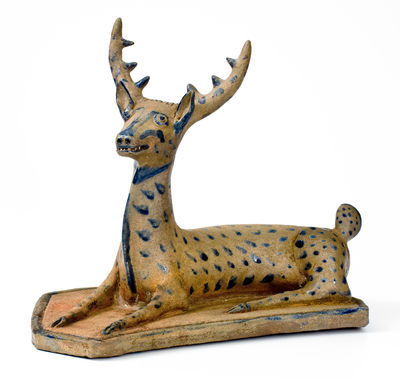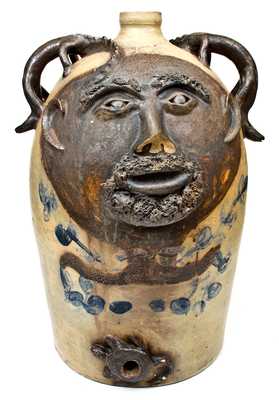Exceptional Stoneware Presentation Harvest Jug with Profuse Incised Decoration, Inscribed "William Seavey. / Caboose No. 1852 / OF / COR", Muskingum County, Ohio origin, circa 1870-1890, domed form with applied tubular pouring spout, arched handle, and pierced vent hole in top, the surface covered in a glossy brown Albany slip glaze. Front decorated with an elaborate double-stemmed daisy plant bearing numerous blossoms and leaves. Reverse with profuse, intricately-incised design of a two stag's bust, vines, and a single flower, surrounding the inscription "William Seavey / Caboose No. 1852 / OF / COR". One of the most heavily-incised American stoneware harvest jugs that we have seen, this example was made for William Seavey, an employee of the Central Ohio Railroad. The extreme artistry of this example even led the decorator to incise his signature at the base with the initials, "H McP (?)". William Seavey is probably the man by that name found living in Zanesville, Ohio, from about 1867 until 1878, when he died. A Civil War veteran and Maine native, Seavey appears as a quarry worker and laborer in the 1870 census and the 1875 Zanesville city directory, respectively. It is uncertain if this is the man for whom the jug was made, but it bears mentioning that two other Maine Seaveys, a father and son named Gardner and Willis Seavey, were notable brakemen of the time period. Speaking to the extreme danger of the caboose man's job, Willis became famous in 1900 when a horrific crash between Newburyport and Salisbury, Massachusetts, took his life; his train, running on the Boston & Maine Railroad, had been rear-ended "by a 'wild' engine." His father, Gardner, was said in a related article to have "been a brakeman for thirty years." Provenance: A recently-surfaced example, which descended in the family of the consignor. Excellent, essentially as-made condition with a tiny base nick and a minuscule nick to spout. H (to top of handle) 10 3/4".






















